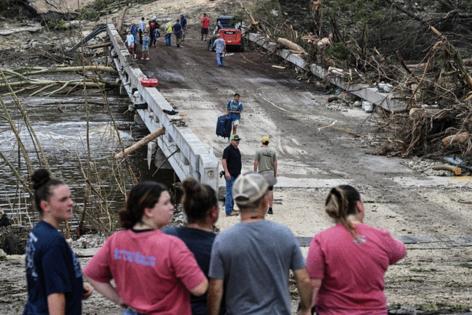After LA firestorms and Texas floods, forecasters haunted by warnings not being heard
Published in News & Features
LOS ANGELES — Meteorologists warned about the chance of flash floods days before Texas' Fourth of July disaster that killed at least 133. Yet, local officials in the hardest-hit areas say they were shocked by the scale of the devastation.
"I have cried on multiple occasions," Chris Suchan, chief meteorologist with WOAI-TV Channel 4, the NBC affiliate in San Antonio, wrote in a recent Facebook post. "At times, I've been overwhelmed with forecaster regret that I could have done more the night before in my weather report."
Forecasters often issue alerts for possible flooding, landslides and "red flag" fire warnings multiple times a year. Sometimes, those warnings are followed by major catastrophes, but other times they are not.
And that has led some to become complacent, rather than heeding the alerts.
Two massive disasters this year — the Texas floods and Los Angeles firestorms — are leading some to grapple with the question of how to get officials and the public to care and take action.
In the case of Texas, Suchan said he is experiencing what he calls "forecaster regret."
That's despite having presented viewers a weather forecast showing "a signal of localized flash flooding" on the afternoon of July 3 — hours before the disaster struck. During the 6 p.m. broadcast later that day, Suchan pointed to an area "where we could see storms develop and then train over the same area. ... And that is a classic flash-flooding signal here in 'Flash Flood Alley.'"
The disconnect between available warnings and the action officials and the public takes has been seen repeatedly over the years, from inadequate preparations in California ahead of fire weather or flood alerts, to the failure of some communities to evacuate ahead of the catastrophic tsunami that hit Japan in 2011.
Of course, there are times when alerts are taken seriously, and forecasters and officials are in the same room. For instance, the publicity around Hurricane Hilary in 2023 reached a fever pitch as it headed toward Southern California. L.A. Mayor Karen Bass stood at press briefings along with then-Fire Chief Kristin Crowley and the National Weather Service. No deaths were reported in California, despite significant flooding and harrowing rescues in the Coachella Valley.
There are other instances where preparation has helped Southern California emerge from periods of severe fire weather or landslide danger — such as through public safety power shutoffs, or crews emptying debris basins to catch mud pouring from landslides.
The National Weather Service office in Oxnard, which issues forecasts for Los Angeles, has also made attempts to more clearly get its messages across. In 2019, the weather service issued an "extreme red flag" fire weather warning that got plenty of attention. During last fire season, the agency issued an unprecedented five "particularly dangerous situation" warnings ahead of forecast extreme fire weather conditions — including one on Jan. 6, a day before L.A. County's devastating wildfires began.
Despite the weather service giving briefings as early as Dec. 30 about forecasted increasing fire weather danger, Bass was overseas in Ghana on Jan. 7, when the fire that destroyed much of Pacific Palisades began spreading rapidly. And the L.A. Fire Department, a Times investigation found, chose not to assign roughly 1,000 available firefighters for emergency deployment in advance of the Palisades fire, which ultimately killed 12 people and destroyed more than 6,000 homes, businesses and other structures.
The Times has previously reported that the day before Bass left for Ghana, her aides received an email, on Jan. 3, from the city's emergency management department warning of "high confidence in damaging winds and elevated fire conditions occurring next week." A spokesperson for the mayor said the email did not suggest imminent catastrophe.
Bass later fired Crowley as fire chief, and accused her of failing to provide adequate warning of the potential for a cataclysmic wind event.
One simple lesson that could be learned from past disasters is that both officials and the public need to better respond to forecasters' warnings.
An after-action report by the weather service from the Joplin, Mo., tornado disaster in 2011 found that most residents didn't immediately head to shelter after hearing the first warning. Among the reasons: apathy, a bias toward optimism and a feeling that sirens were activated too often in Joplin.
But the weather service at that time also said it could do a better job at supporting "effective decision-making," which would help empower people to quickly make appropriate decisions. The agency said it should ensure that tools are in place to easily conduct conference calls with key entities, such as sheriff's offices and other emergency officials.
Suchan remembers listening to weather service meteorologists recall the Joplin tornado, which resulted in 158 deaths — the first single tornado in the U.S. to cause more than 100 deaths since 1953.
"I listened to them describe feeling scarred by the disaster. They asked themselves if their warnings were early enough, strong enough," Suchan wrote in his Facebook post. "The room was very silent through that presentation. It left a mark on me but you can't fully understand that feeling until you experience it for yourself."
In Texas, flooding alerts circulated in the hours and days before the Fourth of July disaster. On July 2, Texas state officials, citing the weather service, warned that "heavy rainfall with the potential to cause flash flooding" was anticipated over the following days. They said swift-water rescue boat squads would be available to assist with flood rescues.
At 1:18 p.m. on July 3, the weather service issued a flood watch for Texas' Kerr County and other areas. On July 4 at 1:14 a.m., a flash-flood warning was issued, sounding the alarm for "life threatening flash flooding."
At Camp Mystic, where at least 27 campers and counselors died, leadership was aware of the earlier flood watch, and also got a cellphone alert of the weather service's flash flood warning at 1:14 a.m. But they did not begin to evacuate campers in cabins near the Guadalupe River until more than an hour later, the Washington Post reported. The Post reported that waters began rising at the all-girls camp around 2 a.m., and breached at least one cabin around 3 a.m. Parts of Camp Mystic are considered at high risk of flooding, according to the Federal Emergency Management Agency.
At a different camp along the same river, Presbyterian Mo-Ranch Assembly, a facilities manager saw the river rising around 1 a.m., and told his boss, who had been monitoring reports of the storms approaching, the Associated Press reported. Camp officials there acted quickly to relocate 70 children and adults from a building near the river, and no one died. There was no warning from local authorities, the AP said.
In an interview, Suchan said he wonders "are there things that you could have done faster, stronger, or do things differently?"
"We're looking at a massive casualty event and it weighs on my heart," he said.
His counterpart at a local CBS affiliate offered a similar warning ahead of the flooding. Bill Taylor, weather chief at KENS-TV Channel 5 in San Antonio, showed a forecast weather model showing a severe storm "just sitting still" for hours in the area around Kerr County.
"This would be a huge flood problem if this happens," Taylor told his viewers on July 3.
In an interview, Taylor said he doesn't feel guilt about how he conveyed his forecast, saying he gave all the information he had about the flood risk. Still, "moving forward, in all honesty, I've even thought to myself recently how much of my verbiage will now change because of this disaster."
He and other forecasters say they hope people take things like flood watches more seriously moving forward, especially if they live in or visit low-lying areas prone to flooding.
"When we say 'flood watch' in this region, I mean, you've really got to be paying attention," Taylor said.
One lingering question is how closely officials in Kerr County — like the sheriff's office and emergency managers — were monitoring the storm.
"If those emergency managers were sleeping that night, oh my gosh ... they won't have a job anymore," said Alex Tardy, a former weather service meteorologist who owns Weather Echo, a consulting company.
Alerts about possible future floods should've triggered some kind of action well ahead of the storm — especially given the campgrounds located in the area, Tardy said.
Suchan said a proper alerting system should be installed along the Guadalupe River. He noted that further downstream in neighboring Kendall County, the community of Comfort has sirens that were activated to warn of flooding on July 4, "and there were no casualties."
"I don't want to ever see a nightmare like [this]," Suchan said. "It's 2025. We shouldn't be doing this."
©2025 Los Angeles Times. Visit latimes.com. Distributed by Tribune Content Agency, LLC.










Comments